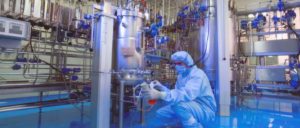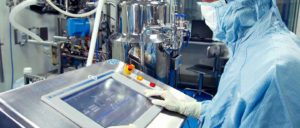With a three-year revenue CAGR of 19 per cent driven by the growing demand from emerging markets, the biopharmaceuticals player, Biocon, has come a long way since its inception in 1978. It has seen business model rejigs, entry into global markets and an initial public offering. Its leader, Kiran Mazumdar-Shaw, aims to make the Rs. 2,800 crore company a global force to reckon with. She talks to us about her vision for the company and what it takes to build a global business
 “If you fix yourself in one spot, I don’t think you will do justice to your entrepreneurial potential,” says Kiran Mazumdar-Shaw, founder, chairman and managing director of Bengaluru-based Biocon Limited. She could well say that, as her entrepreneurial journey reflects this theory. For Mazumdar-Shaw, it has always been about experimenting, exploring, addressing different and diverse opportunities and taking forward a few of them. She set up Biocon as a specialty enzyme manufacturer and exporter and its business model has evolved over the last 33 years. Today, it is balanced broadly between products and services; biosimilars, novel molecules and generics; emerging and developed markets. Biocon has now become India’s largest biotechnology company with a turnover of over Rs. 2,800 crore and a market capitalisation of approximately Rs. 5,900 crore.
“If you fix yourself in one spot, I don’t think you will do justice to your entrepreneurial potential,” says Kiran Mazumdar-Shaw, founder, chairman and managing director of Bengaluru-based Biocon Limited. She could well say that, as her entrepreneurial journey reflects this theory. For Mazumdar-Shaw, it has always been about experimenting, exploring, addressing different and diverse opportunities and taking forward a few of them. She set up Biocon as a specialty enzyme manufacturer and exporter and its business model has evolved over the last 33 years. Today, it is balanced broadly between products and services; biosimilars, novel molecules and generics; emerging and developed markets. Biocon has now become India’s largest biotechnology company with a turnover of over Rs. 2,800 crore and a market capitalisation of approximately Rs. 5,900 crore.
Like Mazumdar-Shaw says, every entrepreneur has a unique set of traits that reflects in the way they manage their business. Her strong trait is applying science with financial prudence to build the Biocon business model. Whether it is building the company’s manufacturing assets, taking up research projects, or entering new markets, she believes in taking business risks only if she finds them financially viable. In the process, she has managed to create a strong balance sheet. As the company expanded, she realised that forging partnerships was a cost-effective way of entering the global markets. Whether it is to create affordable drugs and services for global markets, or deliver micro health insurance schemes for the Indian audience, she is very clear about the need to transform the healthcare system, world over.
“We are developing a fusion protein that targets both tumours and the immune system to kill cancer cells. So far, the mouse data is looking good. Survival is much better. And this is not about adding just few more weeks to a cancer patient’s life. It is about transformational change. ‘Cancer Care’ to ‘Cancer Cure’ is an objective for me. We are hoping to take it into the clinical phase late 2012. If it does the same things in humans then it is a huge breakthrough.”
![]()
She has made investments in her personal capacity to provide affordable quality cancer care to the economically weaker sections of society. And for her mainstream business, Mazumdar-Shaw has neatly charted out the route to make Biocon a fully integrated global biopharmaceuticals company with a long term vision of developing novel and affordable biotherapeutics. Through our discussion with her, we aim to understand what it took to make Biocon a Rs. 2,800 crore enterprise and its future growth strategies, the complexities of managing a product development company in addition to managing a string of partnerships.
Envisioning Biocon’s future
Mazumdar-Shaw wants Biocon to be known as a company that is focused on innovation to develop and deliver high quality drugs for global markets in an affordable way to patients, partners and healthcare systems. To achieve this, she plans to leverage India’s low-cost innovation base and has made headway through several strategic research and marketing partnerships.
She also wants to further strengthen Biocon’s presence in certain areas of treatment for diseases like diabetes, cancer and the auto-immune space. The company is already a leading player in the insulin space with its diabetology division ranked fourth in the overall insulin market and number one in the Glargine vial market. In line with its overall vision, the company’s business has been shaped into five growth verticals – small molecules/APIs, biosimilars, branded formulations, novel molecules and research services. She expects these verticals to collectively deliver a sustainable double digit CAGR (compound annual growth rate) over the next five years.
The growth drivers
Biocon wants to drive a much higher growth than what it gets from just supplying APIs (an active pharmaceutical ingredient is a substance used in the manufacture of a drug which becomes its active ingredient) to generic pharmaceutical manufacturers. Since the APIs business is vulnerable to shrinking margins and commoditisation, it is looking to move up the value chain by developing formulations and marketing them independently or with regional partners in different markets across the globe. But Biocon is also clear about making differentiated generics, which will give it more patent protection.
“In 2011, we divested our stake in the German subsidiary, AxiCorp GmbH. When we acquired the company, its business model helped support our foray into Europe. But the whole landscape changed when the German government started imposing heavy tax on the drugs sale price which left us with wafer thin margins. It would have also left us in a loss making situation and that is when we decided to divest our stake. Many entrepreneurs resist taking that decision to exit a business. Once you acquire something, you feel you are stuck with it. We experimented with it for two years and when things were not doing well later, we exited before it was too late.”
![]()
Biocon’s biosimilar vertical includes biosimilar insulins and biosimilar biologics (includes MAbs – monoclonal antibodies and GCSF – granulocyte colony stimulating factor). Biosimilars or biogenerics are generic forms of biopharmaceutical molecules developed using biological processes. The global opportunity for biosimilars in the insulin and insulin analog space is expected to be US $ 20 billion by 2020. While there are steep entry barriers in the U.S. and European markets, there is still a huge opportunity for biosimilars in emerging markets. “Even if we capture 5 per cent of this total market, it is quite a large market for us,” says Mazumdar-Shaw.
The emerging markets are growing at a much faster rate than the developed markets – developed markets are growing at 5 per cent per annum (p.a) and the emerging markets are growing at 14 per cent p.a. For Biocon, until 2008, the U.S. and Europe accounted for about 75 per cent of its business while it was 25 per cent from the rest of the world. Currently, it is at a 50:50 level. Biocon’s business strategy is to further focus on expanding its presence in these growing emerging markets through strong regional partnerships. It has already partnered with Pfizer (for insulins, development and commercialisation) and Mylan (development, manufacturing, supply and commercialisation) to strengthen its biosimilar presence globally.
Its branded formulations (drugs sold under the company’s brand) business (like diabetology, oncotherapeutics, cardiology, nephrology, immunotherapy and comprehensive care) is India-centric and is growing at 40 per cent p.a. While in many of these segments, the company was a late entrant; it has already managed to gain a leadership position for some brands. Insugen, an anti-diabetes drug, is among the top three brands in the country; Metadoze, an oral anti-diabetic agent, is listed among the top 10 brands while Basalog(TM) commands the number one position in the Glargine vials category. Now, Biocon is all set to capture its share in the Indian pharmaceutical market, which is expected to quadruple in the next 10 years. According to McKinsey, the Indian pharmaceutical market is expected to grow at a CAGR of 15 per cent over the next 10 years.
Under the novel molecules (high potential research-based products) vertical, Biocon is creating high-value licensable assets like oral insulin and drugs for oncology, such as a bi-specific fusion protein that targets the tumour and stimulates anti-tumour immunity. It has also completed a phase III psoriasis trial on more than 200 Indian patients and will spend the next year on getting more validations for it. It has a research partnership with Mylan Inc. for high-value generic biologic compounds.
The increasing trend of externalising research and development to cost-effective research hubs in Asia is allowing companies to control their research spending without shrinking their R&D pipelines. Through its subsidiaries Syngene International (a contract research organisation) and Clinigene International (a clinical research organisation), Biocon is well positioned to capitalise on this trend.

These two divisions have seen an improvement in profit after tax (PAT); from a break-even last year to a PAT of US $ 5 million in the first half of FY12, on a comparative basis. Biocon’s partnership model has evolved over the years and the company is now pursuing an innovative research-driven business model, which is more about creating and sharing intellectual property (IP).
The affordability factor
According to Mazumdar-Shaw, affordability of drugs is going to be the crux for the company’s growth strategies. Its base in India will help it create a global biopharmaceutical model that will address the aspect of affordability. Biocon has a good talent base, low-cost infrastructure and a low-cost scientific talent pool. It has high-end scientists doing the same kind of research that their counterparts in the West are doing, at a fraction of the cost. “The cost to company for a Ph.D in the U.S. is anywhere between US $100,000 to US $200,000. In India you can hire Ph.Ds with a similar profile for half to one-third of that salary,” observes Mazumdar-Shaw. The company wants to use this low-cost base to leverage high-value which is what innovative generics is all about. “We are trying to develop molecules in India up to a point where we know that the product works; where we know that even if we fail we have not spent too much money on it. And once we have learnt about that molecule, we are able to increase investments in a more risk mitigated way. This, in turn, becomes a high-value licensing asset,” shares Mazumdar-Shaw. She adds that Biocon can design future studies globally in a much more informed and cost- effective way, and also know that the probability of success is much higher.
Policy-related changes
“This is a big concern area for me because so far India has been pursuing the generics path instead of drug innovation. Hence, a proper understanding of how new drugs need to be developed is very poor,” says Mazumdar-Shaw. This has led to resistance in providing permission to perform clinical trials. “The media adds to the paranoia against conducting clinical trials on humans. They are speaking from a lack of proper understanding of the whole process,” she reasons. One just needs to conform to the ethical guidelines and become a part of the whole clinical trial ecosystem. Unless there is a strong environment for innovation, it is hard to become global. Taking the lead to become a global player, in 2006, Biocon launched BIOMAB, an anti-cancer, therapeutic MAB-based drug for treating solid tumours of epithelial origin such as the head and neck, for which it had done the clinical and process development.

Managing uncertainties in product development
Biocon has made failure a part of its risk management strategy. While research for fusion protein (designed to stimulate anti-tumour immunity and is expected to circumvent the tumour-induced immune tolerance) under the novel program has been going on for the past three years, the current positive outcome is after two failures. Mazumdar-Shaw says, “The important thing is to learn from that failure and give it another go.” But she warns, “You might finally have to give up.” If the third approach in the protein fusion program had not worked, Biocon was ready to give it up. Currently, this program is seeing success at the mouse model level of testing. The company still has to take it to the clinic. “If it does not work on humans, then we have to go back and see if it is worth tweaking it,” shares Mazumdar Shaw.
In most research programs, the initial spend is low. It is only when it gets to the clinic level that the costs become high. Biocon will soon address this big area as a large number of its programs are getting into the clinic phase. The company aims to defray these costs by accessing grants, taking low interest innovative loans and forging co-development partnerships where the partner pays for clinical development. Biocon, along with Amylin Pharmaceuticals, is working on solving the world’s obesity and diabetes problem through a hybrid peptide molecule. In fact, Amylin has filed a U.S. IND (Investigational New Drug) for its novel molecule.
Building alliances and partners
Partnerships – both for marketing and research – are an integral part of Biocon’s strategy. Some of its partners include Mylan, Amylin, IaTRICa Inc, Vaccinex, Pfizer and Optimer. To make partnerships work, the most important thing to do is to have a clear set of expectations from each other with very clear descriptions of roles and responsibilities. The risk sharing factors between partners should also be clearly documented. If an alliance does not work too well, one needs to decide whether to exit or stay with the partnership and rebuild it again. “But if you want to get out of a partnership, do it in two years. Most misalignments take place within one or two years. Once you cross that time frame, it means your partnership is working,” advises Mazumdar-Shaw.
Going forward, Biocon will continue to forge alliances, as it is a cost-effective way of entering a market. “In the emerging markets, it is good to deal with regional partners, who are strong in that region. They will do a much better job of market penetration and marketing than someone coming from the outside,” says Mazumdar-Shaw. She has also never felt very comfortable acquiring companies and trying to run them from India. Even when Biocon bought the German company, AxiCorp GmbH, it had a hands-off approach in running it.

Global brand building
For companies with global ambitions, brand building is fairly crucial. “If I select a handful of Biocon brands and make sure that I forge relationships and alliances in different parts of the world to market that brand, I can start making a global impact,” says Mazumdar-Shaw. If Insugen, a strong brand in India, is taken to the other parts of the world through a regional partner, it will help in building the Biocon brand as long as the company’s logo is there on the cartridge or vial. “Over time, you need to raise the decibel level by making sure that you invest more in brand promotion,” shares Mazumdar-Shaw. While initially the company just wants to enter the global market, its future strategy is to participate in exhibitions and other promotional activities to market the brand and build its visibility. The company regularly participates in various global events like Bio, Informax, Contract Pharma and AAPS (American Association of Pharmaceutical Scientists) in the U.S and Bio-Europe and Cphi Worldwide in Europe.
Talking on challenges of rising to global heights, Mazumdar-Shaw says, “It is about managing scaling issues pertaining to capital investment, infrastructure support and talent availability. It is also about managing financial and operational risks that escalate with scale.”
To be a global player in the insulin space, Biocon has developed relationships with regional partners for the insulin portfolio in certain markets like Latin America, Middle East and Africa. For other global markets it has collaborated with Pfizer. In order to fuel its global ambition, the company needed to expand its capacity and is in the process of setting up a manufacturing facility in Johor Baru, Malaysia. This facility will cater to the global requirements of Biocon’s range of biosimilar insulin and insulin analogs for diabetes treatment. It will also focus on R&D and production of other biopharma products at a later phase. The company plans to invest around US $161 million in the first phase for setting up the manufacturing facility and expects it to commence operation by 2014. Mazumdar-Shaw says, “This facility in Malaysia will give our products automatic registration in many emerging markets.”
Balancing risk
“I am a big risk taker when it comes to experimenting with my business itself, but I am also financially cautious. I am not the kind of entrepreneur who over leverages a company or even leverages a company’s fortunes to take on big risks. I would want to manage and mitigate risk,” says Mazumdar-Shaw. When she does take business risks, she ensures that the company can fund them internally.
Biocon’s research and manufacturing assets have been created through internal funding. It has not borrowed money to build or to create IP assets. In fact, its debt – equity ratio is at 0.16 times indicating conservative financing and low risk, in terms of debt. “The profits that we accrue are used to invest in the various aspects of our business,” says Mazumdar-Shaw. The company has taken a loan of US $ 40 million to partly fund its expansion plan for Syngene in 2009. “But those are easily repayable from the business,” says Mazumdar-Shaw. She adds, “Most pharmaceutical companies are leveraged because of their acquisition needs. When we made our only overseas acquisition in Germany, it was a small one which we funded internally. Of course, we divested that when it did not make business sense. We did not expose the company’s finances to any kind of large risks.” Typically, Biocon’s annual operational capital expenditure has been around Rs. 150 crore in the past.

The company accessed the capital markets in 2004 offering one crore shares to the public raising close to Rs. 300 crore. It plans to come out with an IPO for Syngene and Clinigene in the next 12-18 months. “I believe that if you can show sustained growth for eight quarters, you are ready to look at an IPO,” says Mazumdar-Shaw. While in 2008-09, the research services division saw a huge mark-to-market loss due to the rupee depreciation, the two companies are doing well now.
Helping the masses
Mazumdar-Shaw set up Mazumdar-Shaw Cancer Centre at Narayana Hrudayalaya as she felt that cancer care needed an affordable model. “The most expensive part of cancer treatment is the diagnostics and if you can reduce that cost by amortising it over a large number of patients or even by having tiered timings and costs based on those timings, you can offer almost free imaging service after a certain time and cross-subsidise it,” she explains. While this investment was made in her personal capacity, as a corporate, Biocon’s strategies are also woven around the affordability factor. Many drugs from Biocon’s product basket are cheaper by 10 per cent to 60 per cent.
On the financial front, the company’s revenues and net profit (excluding licensing income) for the nine months ended December 2011 grew by 15 per cent and 30 per cent respectively. The gross licensing income was down sharply to Rs. 80 crore as against Rs. 120 crore for the same period last year. Its income from research services business grew by 28 per cent on a year-on-year basis while the branded formulations vertical grew by 40 per cent.
There are several developments taking place in the company like the recent launch of INSUPen(R) (a reusable insulin delivery device) and a strong R&D pipeline with two late stage candidates and many early stage programs that have value creation potential through licensing. This coupled with its strong focus on emerging markets and strategy of forging alliances, Biocon is all set to deliver a 20 per cent CAGR over the next five years and provide long term value to all its stakeholders.
BUILDING FAITH IN BIOMAB
“For a long time, we were competing with a multinational company. We believed that the BIOMAB molecule was far safer and efficacious than its competition. But since our competition had survival data and financial backing for their product, it was difficult for us to compete with them. The doctors wanted data and we did not have that kind of environment in India to prepare this data. Doctors are now doing research and bringing in survival evidence of new drugs and products. Now, we have five years survival data of BIOMAB. Eventually, patients and doctors have started having faith in the drug.”
EXECUTIVE SUMMARY:
Biocon, incorporated as a specialty enzymes manufacturer, has come a long way in the last 33 years of its journey. It was the first Indian company to manufacture and export enzymes to the U.S. and Europe. A few years later, it started focusing on research and development to develop novel enzymes. The company subsequently entered the biopharmaceuticals space leveraging its technology platform. Today, it focuses on the business of active pharmaceutical ingredients (API), branded formulations and biosimilars, and it divested its enzymes business five years ago. Mazumdar-Shaw talks about her vision for Biocon’s future, managing uncertainties in product development, building alliances and partners, building a venture that can become a global force and the company’s financial strategies.
Biocon wants to develop and deliver high quality drugs for world markets in an affordable way to patients, partners and healthcare systems. To achieve this, it plans to leverage India’s low-cost innovation base and establish strategic research and marketing partnerships.
The company has made failures a part of its risk management strategy. It understands the importance of learning from them and is prepared to give up research when it hits a dead end.
Partnership is very important for Biocon’s growth strategy. The challenge is to manage the expectations of the partners and define clear roles and responsibilities.
Biocon’s research and manufacturing assets have been created through internal funding. It has not borrowed money to build or to create IP assets.
KIRAN MAZUMDAR-SHAW ON OPPORTUNITIES FOR NEW BIOTECH ENTREPRENEURS
Developing new molecules is a very expensive proposition for a startup entrepreneur. But there are other low hanging opportunities in the biotechnology space like companion diagnostics. We know that there are responders and non-responders to most drugs. An entrepreneur can come up with a diagnostics solution that link a responder to a drug. Today, biologics, especially in cancer area, has potential to have companion diagnostics. If a scientist-entrepreneur develops companion diagnostics for an existing drug, it can be sold to the company that is developing that drug.
Another option is in-silico design (performed on computer or via computer simulation). This will identify which drug will work best based on the structure of the drug molecule and its side effect profile. One could improve the design of the drug based on the test outcome.
New formulations and drug delivery devices are also becoming big opportunity areas for startups.
THE OTHER SIDE OF KIRAN
A typical day
I workout at home and usually take the dogs for a walk in the morning. Then I have a quick breakfast (not much of a breakfast person) and get to work. I spend the first hour going through all my emails during which I might even tweet about. During the day, I have a series of meetings lined up – both internal and external. There could be an interview or I might be speaking to a group of students. And as my day ends, I go home and unwind. I don’t socialise much during the week. My mother comes home for dinner almost every night. I watch the news, read a little and turn in.
How do I unwind
I take short breaks with my family. I just came back from one such break from Paris, where I visited my brother and his family. I love art and I visited three art exhibitions there. I also like to go to the Maldives often where I love to swim in the sea and snorkel.
Her management style
I am a very hands-off person. I delegate a lot. But I also stay closely connected. I have follow-up meetings and if I want an answer to something, I pick up the phone and talk to the concerned person. I am very engaged with my people in terms of work. I like people to own their problems and solve them.
Books, movies, et al
I read a diverse range of books. I recently read The Immortal Life of Henrietta Lacks by Rebecca Skloot. I watch movies mostly on a flight. Some recent views were Mission Impossible IV and Carnage. The last Hindi movie I saw was Zindagi Na Milegi Dobara. My favourite actors are Meryl Streep, Tom Hanks, Richard Gere, Aamir Khan and Shah Rukh Khan.
IDEAS FOR TRANSFORMING INDIA’S HEALTHCARE ENVIRONMENT
“I would like to influence the government to create a strong national healthcare system. This area needs public-private partnership. The private sector has a huge role to play in creating the medical ecosystem and infrastructure. The government has an equally important role to play. For instance, it can bring down cost of medicines not by stricter price regulation but by using other measures like bulk buying via tenders and ensuring it reaches the masses through an effective distribution mechanism.
At Biocon Foundation (a trust that offers primary healthcare services to the less-privileged in rural and urban India), we have a micro health insurance model where we charge about Rs. 150 per year as a premium and have covered 60,000 people so far. We work with a network of clinics and hospitals to treat and diagnose the illness of patients. Our limitation is the administrative cost. But the government can do this and more. It can create a micro health insurance model which can cover a larger population at the basic level in order to make healthcare more affordable. In India, 80 per cent of healthcare cost is borne by patients directly. Similarly 80 per cent of healthcare infrastructure in our country is built by private sector. Government needs to do a lot in this direction. It needs to set up more hospitals and more importantly, it needs to improve the quality of healthcare provided in government hospitals.
We all know the sad state of treatment in government hospitals. These can probably be handed over to the private sector, on lease or rentals, to manage and provide good quality services to the patients. The government can focus on insuring people and enabling quality healthcare services being provided to the patients from the same hospital. It also needs to upgrade hospitals, medical colleges and rural health centres.”
